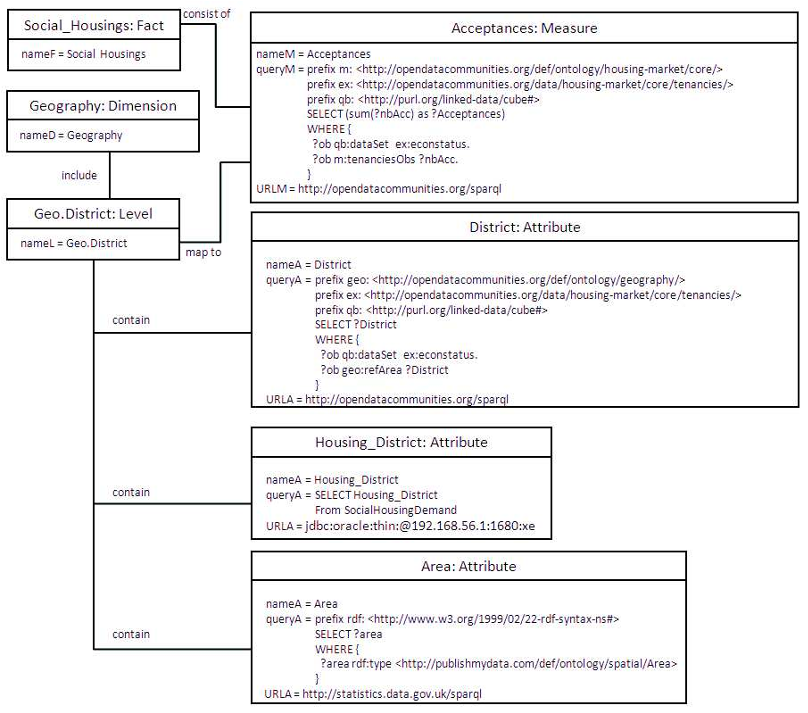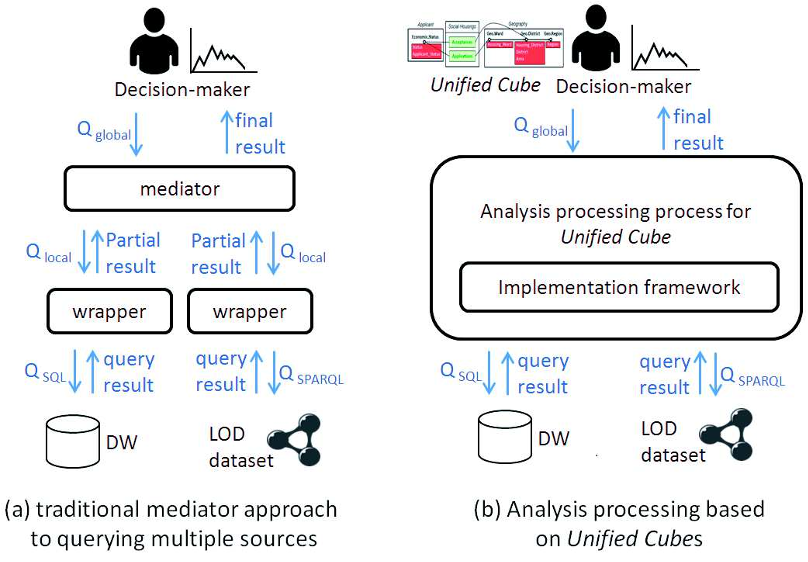and status (cf. figure 1(b)). LOD1 follows a multidimensional structure expressed in RDF Data Cube
Vocabulary (QB)
3
. The QB format only allows including one granularity in each analysis axis. The
decision-maker needs new analysis possibilities to aggregate data based on multiple granularities. To
discover more geographical granularities, the decision-maker looks into another dataset named LOD2.
This dataset is managed by the Office for National Statistics of the UK
4
; it associates several areas
(including districts) with one corresponding region (cf. figure 1(c)). Both LOD1 and LOD2 are real-
world LOD which can be accessed through querying endpoints
56
.
The above-mentioned warehoused data and LOD share some similar multidimensional features, as
they are organized according to analysis subjects and analysis axes. However, analyzing data scattered
in several sources is difficult without a unified data representation. During analyses, decision-makers
must search for useful information in several sources. The efficiency of such analyses is low, since
different sources may follow different schemas and contain different data instances. Facing these
issues, the decision-maker needs a business-oriented view unifying data from both the DW and the
LOD datasets. She/he makes the following requests regarding the view:
• An analysis subject should include all related numeric indicators from different sources, even
though these indicators cannot be aggregated according to the same analytical granularities. To
support real-time analyses, numeric indicators (e.g. Applications from the DW, Acceptances
from the LOD1 dataset) and their descriptive attributes (e.g. Housing
Ward, Housing District
and Applicant
Status from the DW, District and Status from the LOD1 dataset) at different
analytical granularities should be queried on-the-fly from sources;
• Analytical granularities related to the same analysis axis should be grouped together. For in-
stance, the Housing
Ward and Housing District granularities from the DW, the District granu-
larity from the LOD1 dataset, the Area and Region granularities from the LOD2 dataset should
be merged into one analysis axis;
• Attributes describing the same analytical granularity should be grouped together. The correl-
ative relationships between instances of these attributes should be managed. For instance, the
attribute Housing
District from the DW, the attribute District from the LOD1 dataset and the
attribute Area from the LOD2 dataset should be all included in one analytical granularity related
to districts. Correlative instances ”Birmingham” from the DW, ”Birmingham E08000025” from
the LOD1 dataset and ”Birmingham xsd:string” from the LOD2 dataset should be associated
together, since they both refer to the same district;
• Summarizable analytical granularities should be indicated for each numeric indicator. For in-
stance, only the measure Applications from the DW can be aggregated according the Ward
analytical granularity. The other measure Acceptances from the LOD1 dataset is only summa-
rizable starting from the district analytical granularity on the geographical analysis axis.
3
http://www.w3.org/TR/vocab-data-cube
4
https://www.ons.gov.uk/
5
http://opendatacommunities.org/sparql
6
http://statistics.data.gov.uk/sparql






























